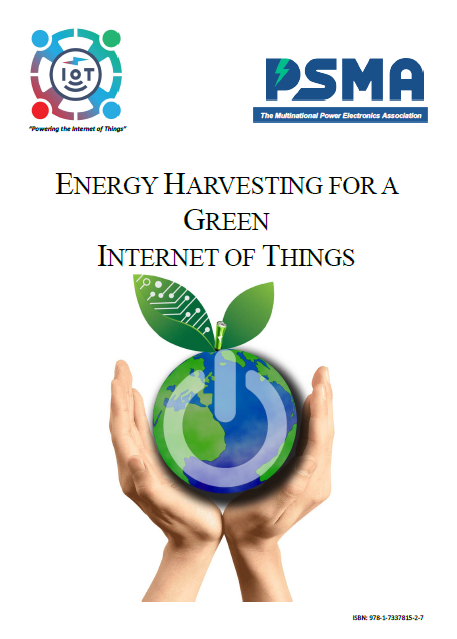Click image to open the white paper.
Executive Summary (click to expand)
This white paper is recommended for everyone dealing with energy harvesting; business leaders world-wide can increase their understanding of the cost and benefits of maintenance-free power supplies. Representatives of environment protection institutions can appreciate the key role of energy harvesting technology. Journalists can learn about a representative set of use cases for reliable and autonomous operation. Decision makers are provided with essential information that allows them to assess the potential of energy harvesting in a given Internet of Things (IoT) applications. Engineers are confronted by the key challenges for future deployment, and researchers explore the need for innovation advancement beyond conceptual technology demonstrations.
This white paper has been prepared by an enthusiastic team devoted to energy harvesting solutions for a green internet of things. The work has been performed on a voluntary basis under the umbrella of the Power Sources Manufacturers Association (PSMA). The composition of the team ranges from scientists, engineers, and small to medium enterprise representatives to industrial stakeholders, offers a broad range of insights into the world of energy harvesting. The key conclusion is that energy harvesting technology has already achieved, in practice and in real environments, the required power density for energy autonomous wireless sensors, as demonstrated in several bespoke use cases. Industry is cautious and slow in adoption of the new solutions due to the requirement for application-specific power supply design for each use case. A turn-key solution with guaranteed functionality and reliability is an essential requirement of industrial users and forms a key missing element in energy harvesting. The high economic and environmental advantage of energy autonomy; due to functionality, maintenance, reliability, and low waste/pollution benefits; makes it essential to sustainable IoT. Addressing these key missing elements, through targeted scientific focus and investment by the environment and technology stakeholders, is a topmost priority.
For the convenience of the interested reader, the content is divided into five sections: Section 1 tours different harvesting device types – able to transfer ambient into electrical energy – focusing on operational concept, performance, and shape. The use cases in Section 2 describe the procedure of developing energy autonomy solutions for Wireless Sensor Network (WSN) nodes, including several representative application examples. A critical review of missing aspects for rapid industrial adoption is given in Section 3. Cost-benefit analysis and life-cycle assessments studies are provided in Section 4, revealing the key role of energy. The future research needs are outlined in Section 5, offering a holistic view of the innovation potential of energy harvesting toward a green Internet of Things.
Lead Editors: Thomas Becker, Michail E. Kiziroglou
Chapter Editors: Thomas Becker, Maeve Duffy, Bahareh Zaghari, Michail E. Kiziroglou
PSMA: Mike Hayes, Brian Zahnstecher
Authors:
|
Name |
Affiliation |
Place |
|
Becker, Thomas |
thobecore consulting & research |
Bremen Area, Germany |
|
Borjesson, Viktor |
ReVibe Energy |
Gotenburg, Sweden |
|
Cetinkaya, Oktay |
University of Sheffield |
Sheffield, United Kingdom |
|
Chen, Baoxing |
Analog Devices |
Wilmington, USA |
|
Colomer-Farrarons, Jordi |
University of Barcelona |
Barcelona, Spain |
|
Duffy, Maeve |
National University of Ireland |
Galway, Ireland |
|
Elefsiniotis, Alexandros |
-/- |
Munich, Germany |
|
Govoni, Leonardo |
AED Engineering |
Munich, Germany |
|
Hadas, Zdenek |
Brno University of Technology |
Brno, Czechia |
|
Hayes, Mike |
Tyndall National Institute |
Cork, Ireland |
|
Holmes, Andrew S. |
Imperial College London |
London, United Kingdom |
|
Kiziroglou, Michail E. |
Imperial College London |
London, United Kingdom |
|
La Rosa, Roberto |
ST Microelectronics & Ecole Polytechnique Federale de Lausanne |
Catania, Italy & Lausanne, Switzerland |
|
Miribel-Català, Pedro |
University of Barcelona |
Barcelona, Spain |
|
Mueller, Jan |
Airbus |
Hamburg, Germany |
|
Pandiyan, Akshayaa |
Imperial College London |
London, United Kingdom |
|
Plasek, Otto |
Brno University of Technology |
Brno, Czechia |
|
Riehl, Patrick |
Analog Devices |
Wilmington, USA |
|
Rohan, James |
Tyndall National Institute |
Cork, Ireland |
|
Sabaté, Neus |
Fuelium |
Bellaterra, Spain |
|
Saez, Manuel |
AED Engineering |
Munich, Germany |
|
Samson, Dominik |
Elatec |
Puchheim, Germany |
|
Sebald, Johannes |
Ariane Group |
Bremen, Germany |
|
Spies, Peter |
Fraunhofer IIS |
Erlangen, Germany |
|
Vikerfors, Andreas |
ReVibe Energy |
Gotenburg, Sweden |
|
Yeatman, Eric M. |
Imperial College London |
London, United Kingdom |
|
Zaghari, Bahareh |
Cranfield University |
Cranfield, United Kingdom |
|
Zahnstecher, Brian |
PowerRox |
San Jose, United States |
.


